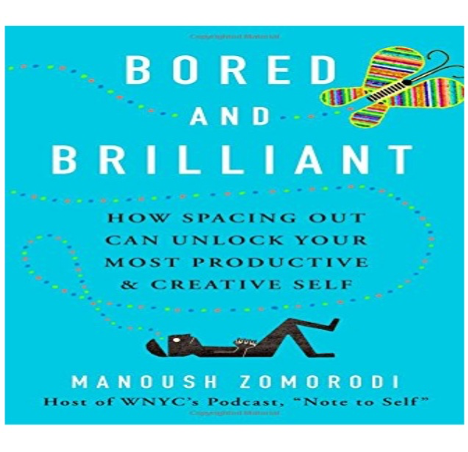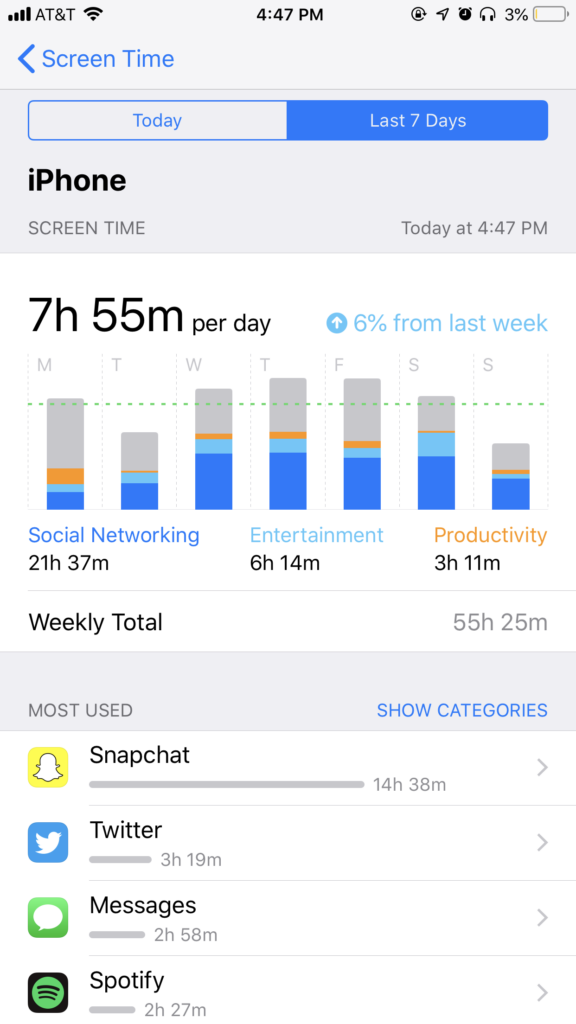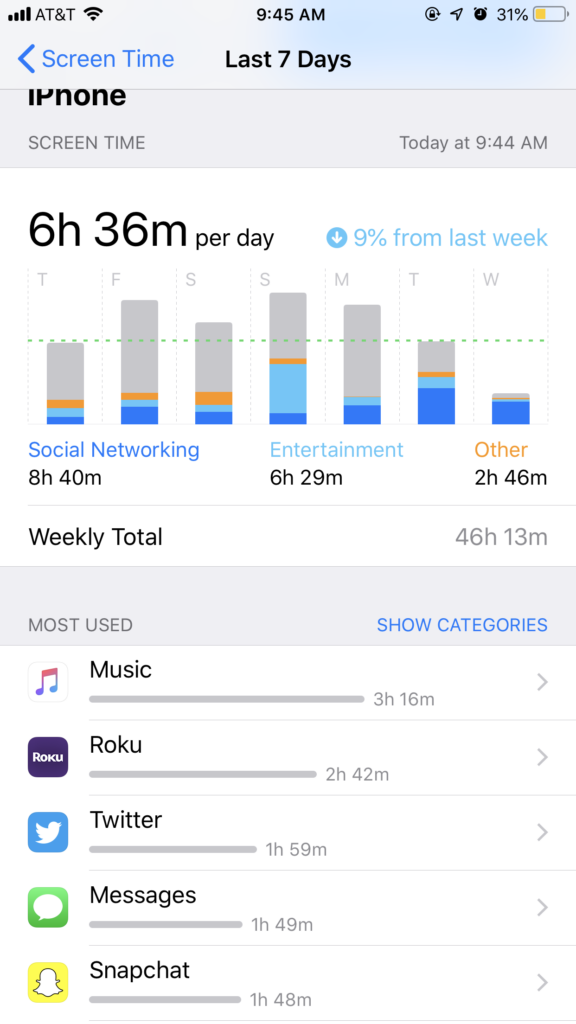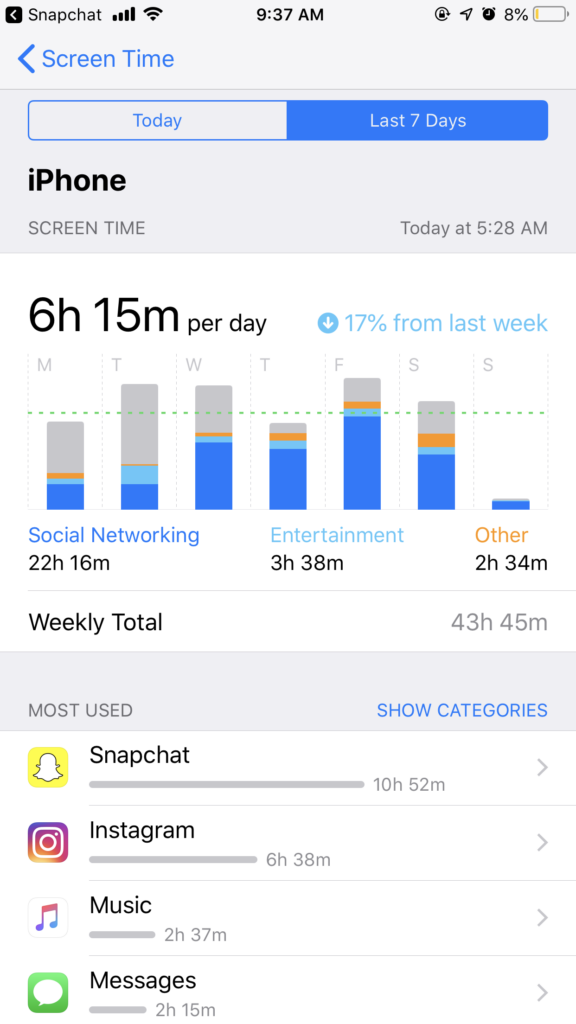How can we request for more time? Simply twenty- four hours a day is not enough. This is the reality of the issue. If we consider our Individual wellness–which consist of seven subsections, Spiritual, Emotional, Intellectual (Academic), Financial, Environmental, Social, and Physical wellness–I bet you could make a list of multiple things you could improve on in these categories. There are only 168 hours in a week and if we take into consideration the time that should be spent on daily activities such as hours per class, hours that should be spent out of class, job hours, fitness, sleep, etc.… then roughly 120 hours or more are devoted to these activities.
However, of course, each and every one of us has different goals and obstacles we must overcome and there are several ways to approach this. From my experience this semester with the different strategies implemented from the course book and from Bored and Brilliant by Manoush Zomorodi. In efforts to improve how effectively I study, prepare and ultimately how I perform academically, I will incorporate three strategies from the books challenges and strategies we learned through the semester as a class.


When setting my goal for this project I wanted to focus on becoming a better self-relegated learner and performing and doing well in my course work. Upon reflection of my reasons, I contributed it to many things, experience, my drive to perform based upon my motivation, to perform and strive in my academic career. This leads me on to choose the goal of acquiring a 3.2 term GPA this semester. Planning on achieving this goal I pointed out obvious weaknesses I have as a student such as my organization for example. After so, I constructed plans and strategies I would use to accomplish this goal for the semester.
Strategy 1: Plan it out

This led me to decide and create a planner for my course work for my first strategy that needed to be completed throughout three weeks. This strategy comes from Bored and Brilliant as more of a passive strategy that allows you to be informed of your deadlines in one place. When formatting this strategy, I made sure to fill it out before the week started. Taking in total 19 credit hours between two institutions I also used organizational skills such as simple color coding just to make sure I wasn’t looking at a uniform page.
Reflecting upon my use of this strategy making the planner before I started my week also allowed me to visualize my schedule and good times to set up study blocks throughout the week. Filling out my planner before the week made me motivated and ready to tackle my tasks in the upcoming weeks. It also helped prevented Information Overload, a process described by the author that occurs when you are overwhelmed by information and or tasks that needs to be accomplished in given instances. I find it very effective considering the time spent to fill it and the productivity and motivation it brings through the week as I accomplish my task.
Strategy 2: Stop and Watch
| 1 Hour Study Blocks | Time spent using Stopwatch | Wasted Time |
|---|---|---|
| 3/5/ 11:45- 12:45 (AM) | 37 Minutes | 23 Minutes |
| 3/7 1-2 PM (PM) | 47 minutes | 13 minutes |
| 3/10 4-5 (PM) | 32 Minutes | 28 Minutes |
| 3/19 12 -1 (PM) | 39 Minutes | 21 minutes |
| 3/21 10-11 (AM) | 44 Minutes | 16 minutes |
| 3/25 1-2 (PM) | 41 Minutes | 19 minutes |
| 3/29 3-4 (PM) | 48 Minutes | 12 minutes |
The second strategy I used during my study blocks. I would make sure I have a clean organized study environment prior to the block and only have the things necessary in front of me. I would then used online-stopwatch.com to total the period of the session I spent studying and how much time was wasted overall.
Reflecting upon my time spent using this strategy I found it very effective. Especially when learning and focusing on campus. I would say the time blocks where very productive as regardless of the task I did during the block whether it was studying new material, reviewing or complete course work. accomplished a lot of work in these times.
Strategy 3: Observe and Change!



4
My third and final strategy is the most interesting and embarrassing to discuss. The book Bored and Brilliant, mentioned the challenge of observing your digital trends it was tracked over three weeks using Apples IOS screen time tracking. The setting analyzes your screen time data throughout the week and puts apps into categories to show where most time is spent. It also shows other cool features such as which app you unlock your phone to most with.
Upon reflection of my data, it was interesting to see the trend of total screen time is typically lower at the beginning of the week and rises throughout. It made me realize that I must control my screen time. Because of so thought the three weeks I deleted my most used social media apps during times when I know I needed things done and or if I found it distracting. During this time, I also altered my notification settings disabling notifications from apps that pop up frequently, but I do not use.
Take it Away!
In all taking time to review my course work project it helped my academic wellness. Reading helped me identify my problems as a scholar. Taking so time aside to plan and analyze my flaws allowed me to plan my strategies and work productively.
I definitely hope plan to keep using these strategies in my life. A good example I would recommend to others is going through your notifications and filter the apps you need to be notified by.
My first take away from my first strategy is taking some time asides at that start really goes a long away. My second take away while using the second strategy three is to stay in the zone; make plans for yourself to put in some work, everything else can come later. My third takeaway reminds me to always observe your actions and take the necessary steps to reduce your tendencies.
